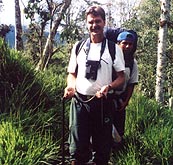 Charlie holding Giant Earthworm
Photo by Sarah Meserve |
|
On an 8-day expedition in November 2003, Charlie Vogt recorded 200 species, of which 130 were new for the area, including Giant Antpitta (4th locality for East slope), a range
extension for the Amethyst-throated Sunangel previously known from Southern Ecuador, Cordillera del Condor and Cutucú, as well as altitude records for 9 other species. In April 2004, Charlie accompanied by Sara Meserve (a student from Williams in SIT's Ecology Program) undertook another 8-day ornithological expedition to Sumaco. More time was spent in the temperate zone with three nights at camp 3 (2770m) and the summit was reached on day 4. 161 species were recorded in total of which 34 species were new to the area. Highlights included Orange-breasted Falcon, Sara and Team at Camp II
Photo by Charlie Vogt |
|
|
Imperial Snipe (known from five other localities on the east
slope), Mountain Avocetbill, Greater Scythebill (an extremely rare bird, Charlie obtained the second known recording for this species), White-rimmed Brush-Finch and Plain-winged Antwren.Boris Herrera led our Mythical Volcano tour in Jan 2007 with an American couple. They recorded 170 species seen and heard and added 14 new species to the Sumaco Volcano list. Yellow-headed Manakin was seen well with a mixed flock, only 2 recent records exist of
this rare foothill species. He also tape-recorded what appears to sound like a Puna Snipe near the summit, previously known from one record of a bird flushed in extreme southern Ecuador. White-rimmed Brush-Finch
Photo by Boris Herrera |
|
|
Join an expeditionary team on a 7-day bird reconnaissance up the Sumaco volcano trail. With funding from GTZ, the local guides from Pacto Sumaco have now completed 3 comfortable huts with flush toilets and gas stoves and are separated by a vigorous 4 hour hike or all-day birding. The trails are steep and muddy and the area receives upwards of 6m annual rainfall. Departure dates correspond to the dryer season. One must be in top physical condition,
possess a sense of adventure and discovery, and appreciate the fact that you will be contributing to ornithological information of a World Heritage Site. All tours will be accompanied by a support team of local residents who will act as guides, porters and cooks which will help develop their community based ecotourism operation.Join an expeditionary team on a 7-day bird reconnaissance up the Sumaco volcano trail.
At present 3 campsites are separated by a vigorous 4 hour hike or all-day birding in our case. While huts will be constructed before November 2004 to provide more comfort, the trails are steep and muddy and the area receives upwards of 6m annual rainfall. Departure dates correspond to the dryer season. One must be in top physical condition, possess a sense of adventure and discovery, and appreciate the fact that you will be contributing to
ornithological information of a World Heritage Site.
Sumaco from crater lake
Photo by Juan Carlos Garcia |
|
|
Tour Itinerary Day 1.
Early-morning start 5 hour drive over Papallacta pass, Loreto road to Pacto Sumaco. Box lunch and begin walk up to Camp 1 carrying your binoculars and day pack while porters carry your backpack. Birding up the trail through open fields and then into dense, lower Subtropical forest looking and listening for Military Macaw, Black-mandibled Toucan, Chestnut-tipped Toucanet, Ash-browed Spinetail, White-streaked Antvireo, Ecuadorian
Tyrannulet and any species new to the area. Arrive at Camp 1 (1850m) before dark with the beautiful view off the ridge up the forested slopes of Guagua (baby) Sumaco and Gran Sumaco. Evening serenade by Rufescent Screech-Owl and Wattled Guan. Day 2. Birding before breakfast around Camp 1, pack up after breakfast, birding up the trail through high canopy forest to Camp 2, listening to 4 species of Thrush, and looking for
Crested and Golden-headed Quetzals, Black-chested Fruiteater, Cock-of-the-Rock, Thrush-like Schiffornis, Chestnut-breasted Wren and possibly the Yellow-headed Manakin, recorded once in Jan 1991. This hut is perched on the rim of a small crater lake on Guagua Sumaco at 2450m in lower temperate cloud forest of mossy trees and bamboo with stunning views between the clouds of majestic Sumaco above and sweeping views below to the Amazon.  Back to top Back to top 
Amethyst-throated Sunangel
Photo by Anders Paulsrud |
|
|
Day 3. Birding all-day around camp 2 looking for Black-and-chestnut Eagle, Andean, Wattled and Sickle-winged Guan's, Spot-winged Parrotlet, Buff-tailed Coronet (few records for the East slope), Tourmaline and Amethyst-throated Sunangel, Black
-billed Mountain-Toucan, listening and looking for Chestnut-crowned, Chestnut-naped, Rufous, Ochre-breasted and Slate-crowned Antpitta as well as wonderful flocks of Tanagers including a possible Red-hooded Tanager.
Day 4. Birding before breakfast then pack- up for hike to Camp 3, looking for Giant Antpitta, Scarlet-breasted, and Green-and-black Fruiteater, more flocks of tanagers and a possible Yellow-billed Cacique as well as unrecorded species.
Arrive at Camp 3 (2900m) at the base of the summit cone in upper temperate cloud forest before dark. Slopes of Sumaco and Amazon
Photo by Juan Carlos Garcia |
|
|
Day 5. Camp 3. Here and above the birds are virtually unknown. Option 1- birding around Camp 3
and returning to camp 2 before dark. Option 2 - if the weather is good and the team is interested and in excellent shape, climb to the summit returning to camp 2 before dark.
Day 6. Birding the trail down to Camp 1 arrive before dark. Date 7. Birding the trail from Camp 1 back to Pacto Sumaco, arrive to receive box lunch. Return to Quito for dinner and overnight in hotel.  Back to top Back to top 
Tour Information
Price per person: Click here for prices
Included: All lodging, meals, expert bilingual birdguide, transportation, hotel transfer and entrance fees.
Not included: Last night dinner; drinks; tips.
See our Payment and Cancellation Policy page for important information.
|